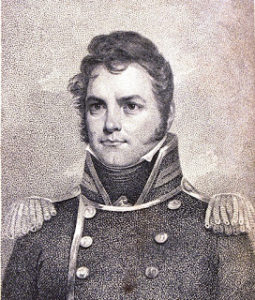On June 30, 1815, Constitution swung lazily at anchor in the Charles River, her crew paid off and dispersed to other ships or to their homes. While they regaled friends, family, and new shipmates with tales of Constitution’s conquests, on the other side of the world some of their fellow American seaman fired the War of 1812’s last shots.
In the waning days of the war, the US Navy had dispatched a squadron of ships to the Indian Ocean to disrupt the valuable British commerce in that part of the globe. The frigate President, under Stephen Decatur, was to be the squadron’s flagship, but she unfortunately fell into the hands of a British squadron soon after leaving New York. Unaware of the President’s capture, the remaining American ships, consisting of the sloops Peacock and Hornet, and the supply ship Tom Bowline, slipped through the British blockade and made it to sea.
After a series of rousing adventures, the three vessels became separated. The Peacock alone continued the mission and sailed on into the eastern Indian Ocean. The 22-gun sloop-of-war was commanded by 33 year old Master Commandant Lewis Warrington. He was impetuous, courageous, dashing, and the illegitimate son of a French nobleman who fought for the American cause during the Revolution. Warrington made a name for himself the year before by capturing the British man-of-war brig Epervier, and fourteen other prizes. Not content to rest on his laurels, Warrington knew he could score some rich prizes in the waters between India and Indonesia.


Sensing danger, Boyce prepared his ship for action. On the Peacock, Warrington seemed unsure of how to proceed. He had prepared his ship for battle, too, but the news of peace between the two nations caused him to waver. The British taken prisoner from the boats claimed to have proof of the peace treaty, in no less a form than President Madison’s own proclamation. Still, Warrington was determined to “have a little brush” with the British, and his subsequent actions were calculated to cause a fight. As the two ships neared each other, Warrington hailed the Nautilus, and ordered her to haul down her colors immediately. Boyce refused, and immediately the Peacock opened fire on her much smaller opponent.
Both sides fired in quick succession, but the Nautilus received the worst of it. Peacock’s first broadside killed two men and severely wounded Lt. Boyce (a grape shot round passed through his body above his hip). The next broadside killed and wounded more men. A 32 lb ball smashed Boyce’s right knee cap and gravely wounded his second in command. With all of the British officers incapacitated, the Nautilus surrendered.
Warrington evidently immediately regretted his decision to open fire, but continued to act petulantly toward the British he had so thoroughly vanquished. He gave the Nautilus back the next day, but continued to insist that he had been in the right. An American court of inquiry later agreed, and cleared him of all wrongdoing.
Warrington went on to a long career in the US Navy, and eventually died in 1851 after fifty years of service. Poor Charles Boyce had his leg amputated above the knee, and had to retire from the East India Company’s service in 1817. Nevertheless, he was awarded a pension by the East India Company and lived to collect it until 1878!
The Author(s)
Matthew Brenckle
Research Historian, USS Constitution Museum
Matthew Brenckle was the Research Historian at the USS Constitution Museum from 2006 to 2016.
